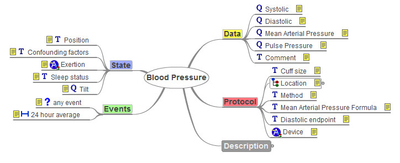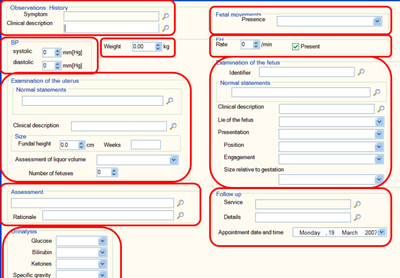...
and many others. From the user's point of view, these are the kinds of data which occur in health information systems. Each archetype is a text file, expressed in either ADL syntax or its XML derivative.
What don't archetypes do (that Templates can)?
Archetypes don't define data sets. A data set is defined by a template in openEHR, which is a special kind of archetype that aggregates bits and pieces of other archetypes to form a set of data specific to a particular use, e.g. a screen form or message definition.
The above form has been templated from archetypes: each red area contains some specific (usually only a minority of) data elements from one archetype.
How do Archetypes and Templates work together?
...
No. Archetypes are designed to provide systematic interface with terminologies. They are, in themselves, terminology-neutral, because there is no (and probably will never be) single terminology or ontology which describes the whole of medicine in the myriad points of view needed in clinical information systems. ADL is designed instead to have bindings to terminologies, and any given archetype can include bindings to more than one. A binding is the set of mappings from archetype local term and constraint codes to terminology codes and query expressions respectively. See the CKM 'Problem' archetype for an example.
What is the difference between archetypes and ontologies?
...
Archetype Definition Language, or ADL, is a formal language for expressing archetypes, and can be categorised as a knowledge description language. It provides a formal, abstract syntax for describing constraints on any domain entity whose data is described by an information model (e.g. expressed in UML/OCL). The syntax is congruent with Frame Logic (PDF of original paper by Michael Kifer) queries. It is It is primarily useful when very generic information models are used for representing all data in a system, for example, where the logical concepts Patient, Doctor and Hospital might all be represented using the class Party, Address, and related generic classes. Archetypes are then used to constrain the valid structures of instances of these generic classes to represent the desired domain concepts. In this way future-proof information systems can be built - relatively simple information models and database schemas can be defined, and archetypes supply the specific modelling, completely outside the software.
The official specification of ADL 1.4 is available here (640k PDFand 1.5 specifications.
(For math/logic geeks: ADL syntax is congruent with Michael Kifer's Frame Logic 'queries').
Is there a Reference Validator or Compiler for Archetypes?
Yes - the ADL Workbench tool, or 'AWB'. See here for help and download.
How can I see what ADL archetypes already exist?
The openEHR Clinical Knowledge Manager (CKM) contains the archetypes managed internationally at openEHR.org. Other archetypes may be managed at a national level within your country or some other organisation.
...
ADL and the AOM are open specifications of openEHR. They have been . The 1.4 release was adopted as ISO standard ISO 13606-2.
...
How do I develop a new archetype?
Technically, you You can download the Archetype Editor and build one.
But if you are serious, you are probably a clinical professional, and will want to discuss requirements and ideas first with others, which you can do on the openEHR clinical mailing list, and also with others registered on the openEHR CKM.
How do I develop Software which Processes Archetypes?
The Archetype Object Model& provides provides a standardised object model of archetypes which can be used as the basis of software. Most likely you will want to capitalise on the work already done in various languages. See the implementation project pages and openEHR technical mailing list.
Who is using the openEHR 'archetype' approach'?
Most of the countries, companies, academic institutions and other projects you see here.
How do archetypes relate to CEN EN 13606?
CEN TC/251 has adopted the openEHR archetype model 1.4 and ADL 1.4 as the means of expressing archetypes to be used in conjunction with EHR data sent as CEN EN13606 EHR Extracts; these specifications are snapshotted in the revised EN13606 part 2. Archetypes created directly based on the EN13606 part 1 model fall into the category of legacy archetypes as defined above.
Note that the The openEHR ADL 1.5 and AOM 1.5 specifications, currently in late draft, supersede the 1.4 specifications used by CEN and ISO 13606.

